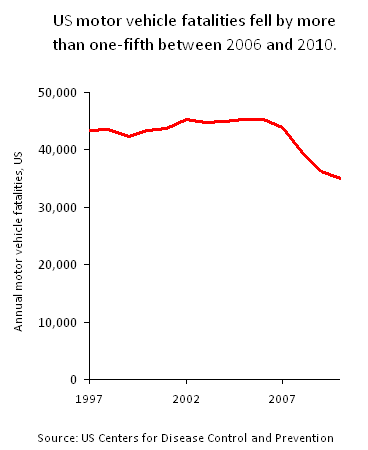You may have seen last week some good news from the Centers for Disease Control: for the first time since 1965, homicide fell off the list of the top 15 causes of death in the US. In fact, as I read the latest numbers from the FBI’s Uniform Crime Reports, the homicide death rate for the first half of 2011 may have fallen to its lowest level since 1958! Booyah!

But the data release also included another piece of excellent news: motor vehicle deaths also fell to their lowest level in decades. As the chart to the right shows, last year’s decline continues a remarkable trend: over just the last 5 years, car crash deaths fell by more than 20 percent. And if you believe this data series from saferoads.org (and the recent data all looks correct to me) traffic fatalities in 2010 were at their lowest level since the 1950s. Double booyah!
But the decline in fatalities is only part of the good news. According to the National Safety Council, for every crash death there are roughly 53 nonfatal injuries and 234 crashes that just cause property damage. So the decline in crash fatalities also means a decline in injuries, trauma, and cash wasted on car repairs.
The crash in car crashes also has huge economic benefits. The NSC estimates that every crash fatality corresponds to $6.8 million in economic losses (a figure that incorporates both fatal and nonfatal crashes, and includes both property costs and losses of economic productivity). So the recent decline in fatalities—which has trimmed the number of crash deaths by more than 10,000 per year—is equivalent to an annual economic boost of roughly $70 billion. And if you consider how much people are willing to pay to prevent being killed or injured in a car crash, the economic benefits of fewer fatal crashes grow even larger.
So amid all of the good news, one question remains: why? Why have car crash rates declined so suddenly and dramatically? I, for one, think it’s a hidden upside to rising gas prices. As gas prices rose, we drove a bit less—and even modest reductions in driving can have outsized benefits for road safety. Meanwhile, as gas prices soared people were less likely to drive (and buy) the largest SUVs and pickups—vehicles that often conferred little or no real-world safety benefits for their drivers, but made the roads much more dangerous for everyone else. There’s more to the story than fuel costs; the stalled-out economy of 2008-2010 also put a crimp in people’s appetite for driving, for example. But it’s hard not to see the decline in car crashes as, at least in part, a silver lining in the rise of prices at the pump.









Jan Steinman
While everyone seems to be cheering about this news, thanks for acknowledging the hidden underlying reasons: reduced economic activity due to high fossil sunlight prices. People who can’t afford to put gas in their vehicle don’t get in accidents.
Most of the people who are thumping their chests and claiming credit for lower traffic deaths are not so willing to take credit for the real cause here.
Personally, I think both the cause and the effect are reasons for celebration, but the celebration won’t be complete until the NTSB starts tracking and reporting horse-and-buggy accidents — coming soon to a declining civilization near you!
Southender
Jan:
Are you correlating driving-rates with social and economic progress? How does that jive with societies whose indicies of wellbeing have all outpaced ours, who haven’t shackled themselves to the personal automobile as the primary mobility-appliance for short or discretionary trips?
I, in an admittedly cursory search of google academic, can’t find any economic or anthropological research that supports the suggestion that driving rates correlate to cultural or societal ascendance or decline.